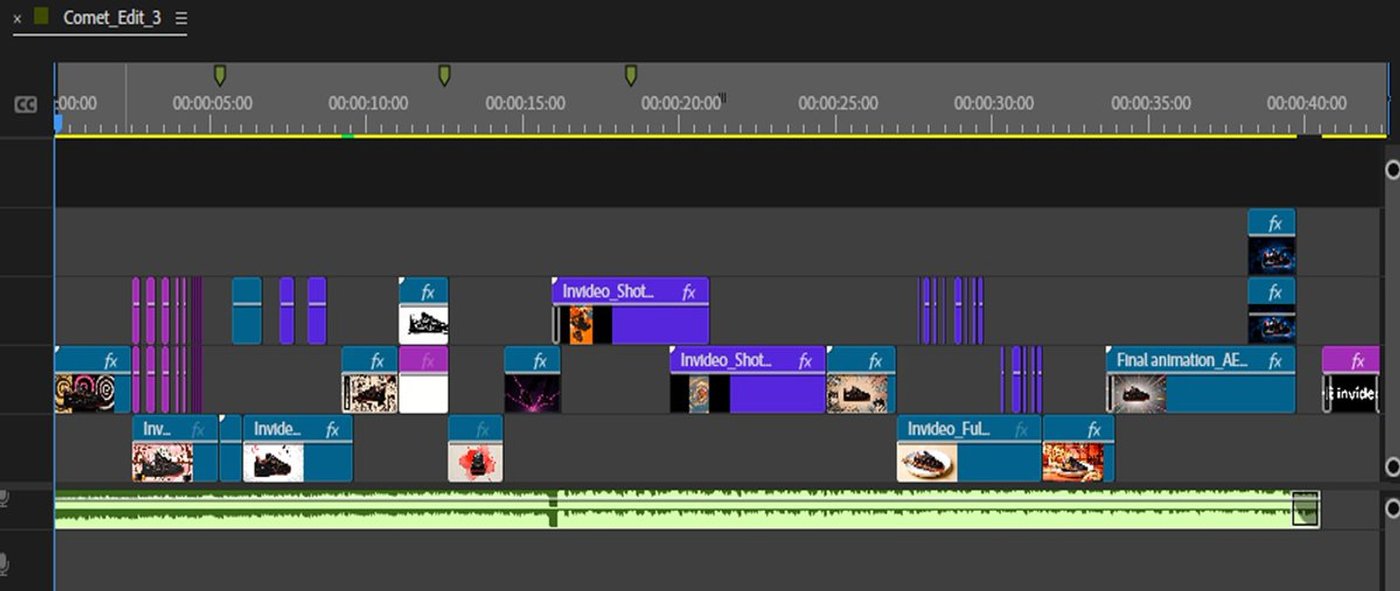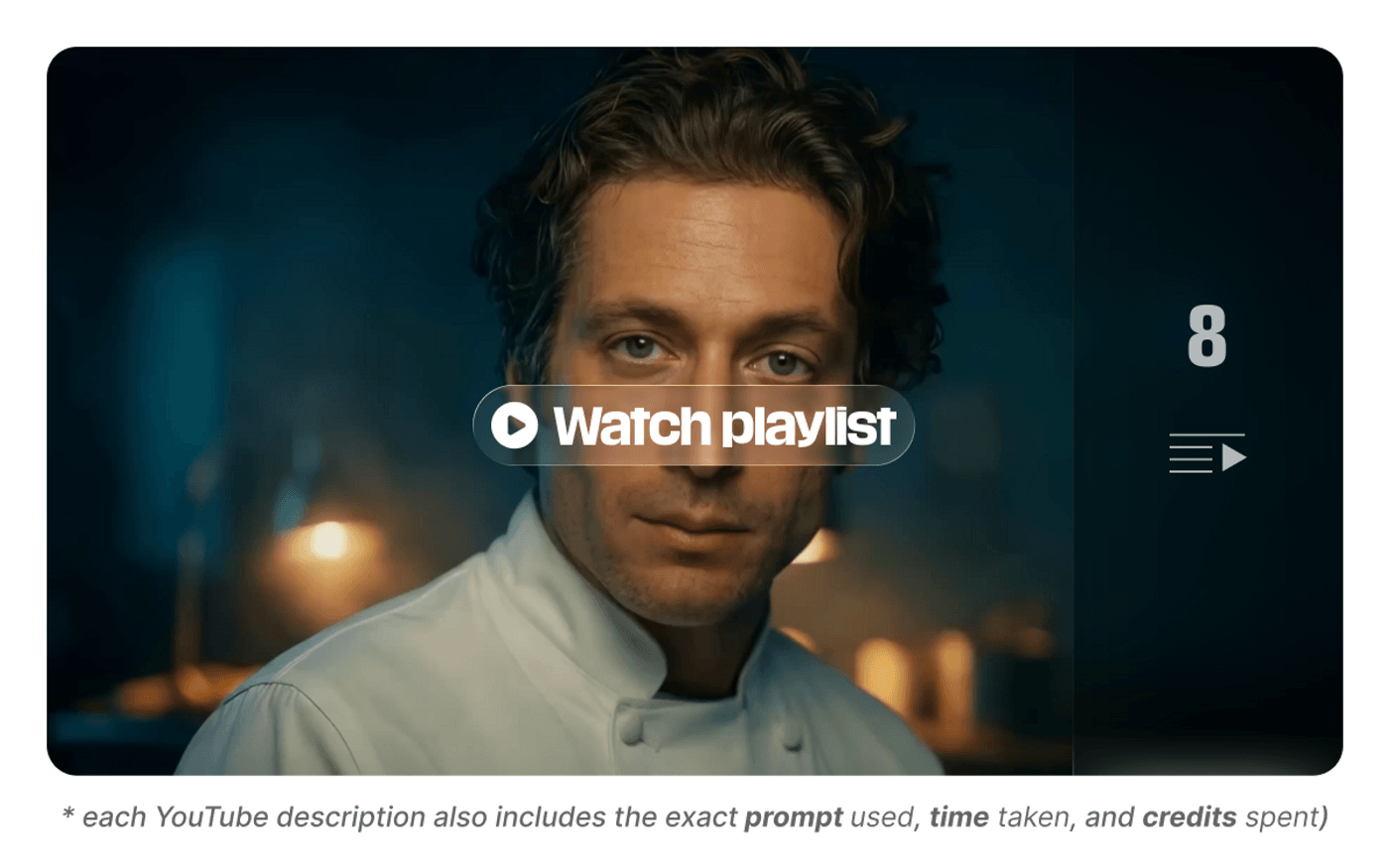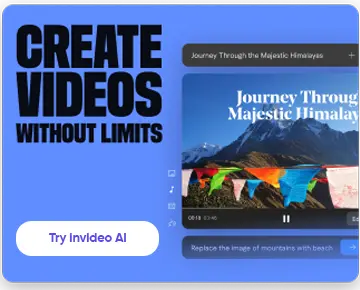Recently, a cult favourite sneaker brand created a sneaker dedicated to a Ramen Bar.
Comet Sneakers teaming up with Naru Noodle Bar for limited-edition kicks that have chopsticks sticking out of them has their fans in absolute delirium.
While everyone’s been talking about the unusual partnership between a restaurant and a sneaker company, Invideo (a leading AI video generation tool) celebrated the occasion by creating a promo befitting the partnership.
Invideo leveraged its expertise with AI video to make a promotional video celebrating this partnership, because, why not?
Afterall, Ramen and sneakers are two of the most popular things at invideo.
A video that would otherwise cost tens of thousands of dollars was done in just $1,500 and it took only 3 days.
Not sure what’s more surprising, the partnership OR the fact that such brand videos can be made by virtually anyone.
Invideo shared how they used invideo AI to create the video for less than the price of just renting all the equipment in a tweet. We were hungry for more details about how he created the video, the tools used, what you can use AI for now, and the future.
So, we sent them questions and found their answers - changes everything for small businesses...
If you read till the end, you'll find not one, but over a dozen such Ad examples that feel like a Million dollars but are created using budgets less than $500.
These ads are across business categories ranging from a Professional services soloprenuer to large corporations like Starbucks & Mercedes.
Traditional Video Production Isn’t for Every Business
Q: You mentioned that creating a video like this the traditional way should cost $40k to $80k. Why is it so expensive? What goes into it?
A:
The costs add up quickly when you break down everything involved. First, you're looking at $15,000-25,000 just for the production crew - that's your director, cinematographer, sound engineer, lighting technician, and assistants for a 2-3 day shoot. Then you have talent costs, which for professional actors can range from $5,000-15,000 depending on usage rights and their profile.
Location fees run $2,000-5,000 per day for studios or permits, while equipment rental hits $8,000-12,000 for cameras, lighting, and sound gear. Post-production costs spiral to $10,000-20,000 for editing, color correction, and motion graphics. Hidden expenses like catering, transportation, insurance, and potential reshoots can add $15,000+ to budgets. With agency markups and necessary buffers, high-quality commercials easily cost $40,000-80,000 total.
Q: But there’s got to be a quality difference, shouldn’t there? It sounds unbelievable that you can create all of this with just AI
A:
You're absolutely right. AI can have quality issues. Text and logos sometimes render incorrectly, characters can shift between cuts, and you'll see unnatural gestures or what’s come to be known as the "AI shimmer" effect. But traditional production has its own problems too - I've seen $50,000 shoots ruined by talent mistakes, lighting issues, or boom mics in frame.
The difference is that traditional production has multiple people catching issues during filming and post-production, while with AI, you're the sole quality control. But for most marketing content, AI's "imperfections" actually help it feel more authentic and less produced. All in all, nothing that can’t be fixed in post-production clean-up.
How AI Can Help with Video Creation
Q: When should brands choose AI over traditional video production?
A:
Use traditional for high-stakes brand films, AI for testing, and content that benefits from feeling real rather than perfect. It removes all barriers and opens new possibilities.
Q: Can ordinary folk with no video creation experience do this?
A:
Absolutely, but with important caveats. Modern AI tools are incredibly user-friendly - you can literally type what you want and get a video. The technical barriers are almost gone. I've seen complete beginners create decent videos on their first try.
However, there's a difference between creating "a video" and creating "effective video content." You still need to understand your audience, craft compelling messaging, and structure content that achieves your goals. The AI handles the production, but it can't fix bad strategy or unclear messaging.
Q: Which niches would AI video work in?
A:
AI video works exceptionally well in several niches. Explainers or How-tos, promos & offer or Ad videos, UGC style customer testimonials at scale, product demos, children’s lullaby videos, and more.
Q: Which tools did you use to create your video?
A:
For our Comet x Naru collaboration video, I used a three-tool workflow that's become my standard approach. ChatGPT served as my creative strategist and director's assistant - I fed it the brand DNA and visual references to create detailed prompts and moodboards for the anime-sneaker-ramen theme.
Invideo AI handled all the heavy lifting - I used their V4.0 platform to generate 15 complete 30-second videos, plus 24 specific shots using their image-to-clip plugin with the GPT moodboards. Out of 200+ clips generated, we got about 50 great shots that formed our foundation.
Adobe Premiere Pro was used for final assembly - finessing pacing, transitions, color matching, and syncing everything to an arcade-style track from YouTube's copyright-free library. The key insight is that AI handles the bulk creation, but human taste and editing skills make the difference between functional and exceptional.
A Walk Through Workflow with Invideo
Day 1: Ideation and Scripting
The sneaker was our visual hero. Keeping it as our starting point, we built worlds of anime and ramen around it.
We used GPT to moodboard and translate our theme of “anime-sneaker-ramen” into detailed visual descriptions for prompting on invideo.
Our process: GPT prompt → invideo video generation → feedback → re-generation
This cycle continued through the project.
Here is the video generation from one of our prompts, as well as the GPT moodboard images.
Here’s the prompt. Simply copy and paste to start creating your videos.
Style Notes for invideo AI
- COMET model must remain 100% consistent — same angle, materials, colors, stitch detail in all scenes
- All backgrounds = hand-drawn anime style, monochrome + single accent tone, consistent sketch technique
- Food = transition device: noodles, sushi, chopsticks, broth, petals, rice
- Each background must animate subtly: zooms, steam, petal drifts, tray motion
- Rapid pace: every 1–2s must deliver new motion or visual surprise
- Editing rhythm matches fast music beat, bold, confident cuts
00:00 – 00:01
Visuals:
- Neutral washi paper background, light ink halo
- COMET model sneaker center-frame, exact realism, slow spin
- Beat hit, slight zoom, drop shadow
- Ink circle pulses behind
Check out the rest of the prompt here…
Day 2: Creation and pre-production
This is where the magic and the mess usually happen. We generated complete 30-second videos with invideo, not just individual clips.
Through invideo we:
→ Generated 15 complete videos (30 seconds each) (invideo V4.0)
→ Made 24 specific shots using our GPT images (image-to-clip invideo plugin)
→ Got ~50 great shots total from 200+ clips
Invideo understands video structure — pacing, transitions, narrative flow.
Other tools give you just clips.
Invideo gave us complete video foundations to build from. Our entire storyboard came to life in invideo.
Day 3: Assembly, editing, and refinement
Premiere Pro for finessing pacing, transitions & color matching
→ Blended varied anime-inspired shots into a cohesive rhythm
→ Synced everything to an arcade-style track from YouTube's copyright-free library
This is where it all clicked.
Here is how our Premiere timeline looked like…

Costs
Q: How much should this cost compared to the traditional way?
A:
The cost difference is dramatic when you see real numbers. Our Comet x Naru collaboration cost breakdown was:
AI Production:
-
Invideo subscription: $500/month (used 493 credits)
-
Creative and execution time: $1,000
-
Total: Under $1,500
Traditional Production Equivalent:
-
India: ~$42,000
-
US: ~$80,000
-
That's a 28x–53x cost difference
But the real advantage isn't just cost - it's speed and iteration capability. Traditional production takes 10-14 days from concept to final delivery. Our AI workflow was 3 days maximum, plus 1-2 days for refinement if needed.
Can you produce such high-quality videos regularly?
Q: Is this a one time wonder or can anyone do this on a more regular basis?
A: I’m glad you asked. Post this, we looked at some of the prompts our users attempted and launched a campaign called Million Dollar Ads.
You can watch the final videos on this YouTube playlist, but if you want the full Prompts + workflow break-downs of these ads on check my X

Where AI Video Lags behind?
Q: This is a great workflow, but what are some things people should be aware of while creating AI videos?
A:
The biggest reality check is the success rate - we generated over 200 clips to get 50 usable shots. That's a 25% success rate, which means 75% of what AI creates doesn't meet quality standards. People assume you prompt once and get perfect results, but it's actually an iterative process requiring multiple generations
Consistency is probably the hardest challenge. Getting the same character, product, or visual style across multiple shots is nearly impossible. In our Comet project, maintaining the exact sneaker appearance across different scenes required constant refinement and careful prompt engineering. Even small changes in wording can completely alter the output, and yet you might find some frames with an issue.
Q: Are there any workarounds to these deficiencies?
A:
The key workaround is planning your content around AI's strengths rather than fighting its limitations. For our Comet collaboration, we designed scenes that leveraged AI's ability to create atmospheric backgrounds and product shots while avoiding complex character interactions.
For consistency issues, we create detailed style guides and reuse successful prompts with minimal variations. Save everything that works - successful prompts, visual styles, and generation settings. Building a library of proven approaches dramatically improves your success rate.
The Future
Q: How do you see AI video evolving?
A:
We're approaching a tipping point where the technical barriers disappear, but creative strategy becomes more important than ever. The next 12-18 months will bring major improvements in consistency and motion quality, making AI video indistinguishable from traditional production for most marketing content.
Real-time generation is coming fast. Instead of waiting minutes or hours for renders, we'll have AI that generates video as quickly as you can type prompts. This will completely change the creative process - you'll be able to iterate and refine ideas in real-time during client meetings or brainstorming sessions.
Q: Any final advice for brands considering AI video?
A:
Start now, but start with realistic expectations. AI video isn't magic - it's a powerful tool that amplifies good strategy and accelerates execution. If your messaging, targeting, and creative concepts are weak, AI will just help you fail faster and cheaper.
Begin with low-stakes testing. Don't bet your biggest campaign on AI video until you understand its capabilities and limitations. Create variations of existing successful content, test messaging concepts, or explore creative directions before committing to major campaigns.


